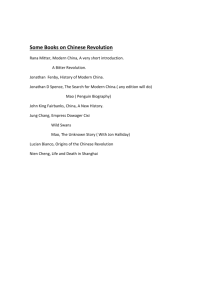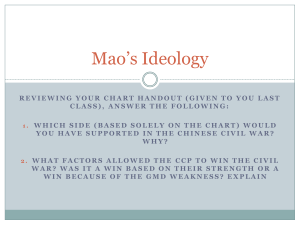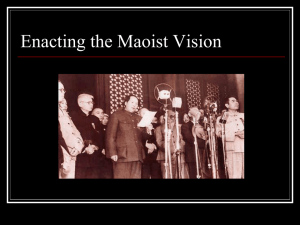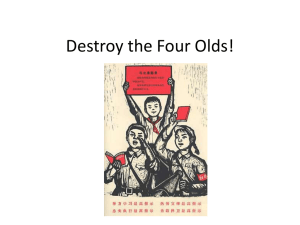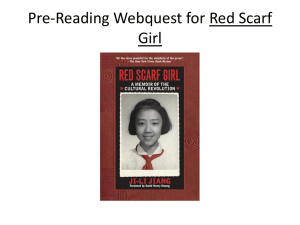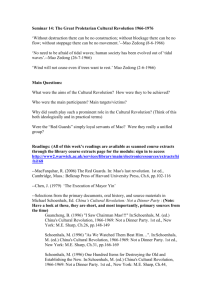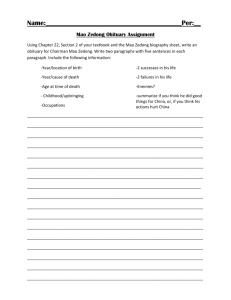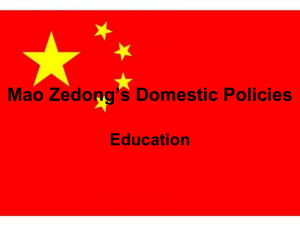THE GREAT PROLETARIAN CULTURAL REVOLUTION
advertisement
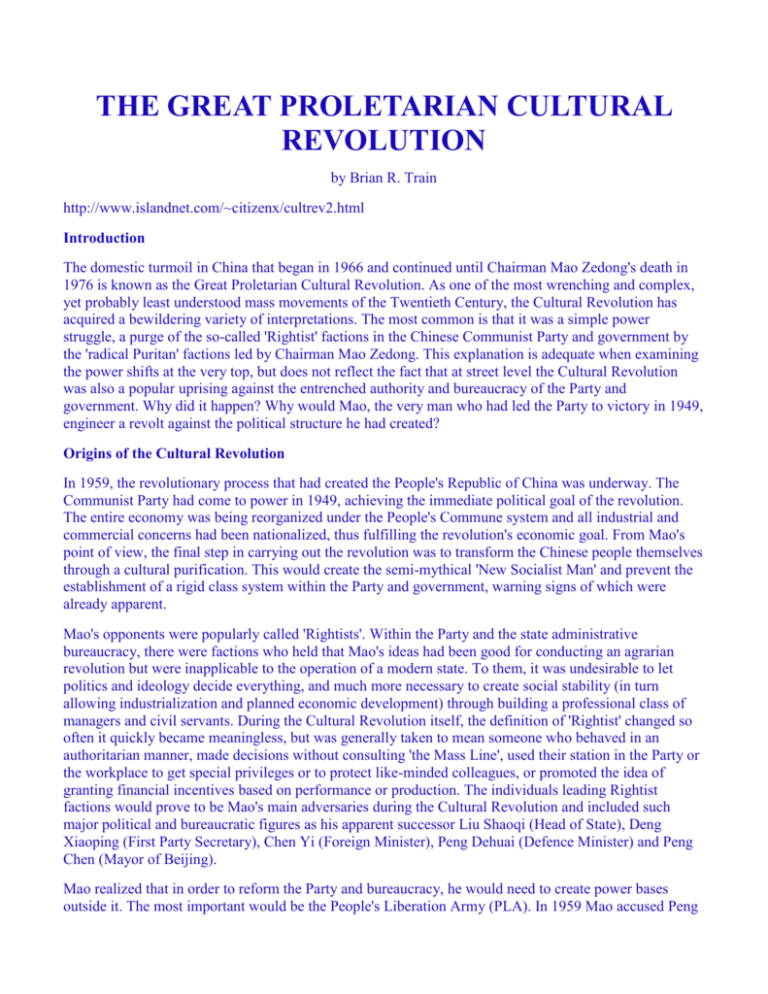
THE GREAT PROLETARIAN CULTURAL REVOLUTION by Brian R. Train http://www.islandnet.com/~citizenx/cultrev2.html Introduction The domestic turmoil in China that began in 1966 and continued until Chairman Mao Zedong's death in 1976 is known as the Great Proletarian Cultural Revolution. As one of the most wrenching and complex, yet probably least understood mass movements of the Twentieth Century, the Cultural Revolution has acquired a bewildering variety of interpretations. The most common is that it was a simple power struggle, a purge of the so-called 'Rightist' factions in the Chinese Communist Party and government by the 'radical Puritan' factions led by Chairman Mao Zedong. This explanation is adequate when examining the power shifts at the very top, but does not reflect the fact that at street level the Cultural Revolution was also a popular uprising against the entrenched authority and bureaucracy of the Party and government. Why did it happen? Why would Mao, the very man who had led the Party to victory in 1949, engineer a revolt against the political structure he had created? Origins of the Cultural Revolution In 1959, the revolutionary process that had created the People's Republic of China was underway. The Communist Party had come to power in 1949, achieving the immediate political goal of the revolution. The entire economy was being reorganized under the People's Commune system and all industrial and commercial concerns had been nationalized, thus fulfilling the revolution's economic goal. From Mao's point of view, the final step in carrying out the revolution was to transform the Chinese people themselves through a cultural purification. This would create the semi-mythical 'New Socialist Man' and prevent the establishment of a rigid class system within the Party and government, warning signs of which were already apparent. Mao's opponents were popularly called 'Rightists'. Within the Party and the state administrative bureaucracy, there were factions who held that Mao's ideas had been good for conducting an agrarian revolution but were inapplicable to the operation of a modern state. To them, it was undesirable to let politics and ideology decide everything, and much more necessary to create social stability (in turn allowing industrialization and planned economic development) through building a professional class of managers and civil servants. During the Cultural Revolution itself, the definition of 'Rightist' changed so often it quickly became meaningless, but was generally taken to mean someone who behaved in an authoritarian manner, made decisions without consulting 'the Mass Line', used their station in the Party or the workplace to get special privileges or to protect like-minded colleagues, or promoted the idea of granting financial incentives based on performance or production. The individuals leading Rightist factions would prove to be Mao's main adversaries during the Cultural Revolution and included such major political and bureaucratic figures as his apparent successor Liu Shaoqi (Head of State), Deng Xiaoping (First Party Secretary), Chen Yi (Foreign Minister), Peng Dehuai (Defence Minister) and Peng Chen (Mayor of Beijing). Mao realized that in order to reform the Party and bureaucracy, he would need to create power bases outside it. The most important would be the People's Liberation Army (PLA). In 1959 Mao accused Peng Dehuai (who had been vocally critical of Mao's policies) of 'anti-Party activity' and replaced him with Lin Biao, a man even more radical in temperament than himself. Under Lin, the role the PLA would play in Chinese politics and society would change drastically. Lin gave the PLA an egalitarian look by abolishing ranks and insignia and replacing the Russian-style uniforms with the 'green pajama' suit. He ensured that Mao would have the political loyalty of the military through organizational changes and political indoctrination. He edited and wrote a preface to Quotations from Chairman Mao, and made its study compulsory for all members of the PLA. This, the famous 'Little Red Book', would become the Bible of the Cultural the sight of huge crowds waving this book and chanting slogans from it would become one of its most enduring images. In 1964 the 'Learn from the PLA' propaganda campaign began. The PLA was held up as the country's best example of correct thinking, revolutionary spirit, and dedication to Maoism. Hundreds of 'soldier heroes', both real and fictional, were displayed as examples of socialist zeal. Mao also worked to secure support from outside the military. The Socialist Education Movement was used to indoctrinate young people, especially in rural areas, with his ideas. This program was most active from 1963-66 and was aimed at elementary and middle school students (ages 12 to 14), who would later form the majority of the membership of the Red Guards. Finally, Mao allowed a 'cult of personality' to develop around himself. Even though he had technically retired as Head of State in 1958 and was Chairman of the Party in name only, Mao was still the undisputed leader of China to the great majority of the Chinese people. He would trade on this strength throughout the difficult years ahead. 1966-69: The Violent Phase The ground had been prepared: it now remained only for a suitable incident to launch the Revolution. In May 1966, Nie Yuanzi, a philosophy instructor at Beijing University, wrote a Revolutionary Big Character Poster that accused the President of the University of suppressing student political activities (these large handwritten screeds, pasted one over another on every public wall, would be the major medium of propaganda and debate during the Cultural Revolution). Mao ordered the text of the poster to be published in People's Daily, China's main newspaper. This inspired students across the country to begin questioning their teachers and local Party leaders on their political orthodoxy and accusing them of Rightist activity. Liu Shaoqi tried to defuse the situation by sending 10,000 Party cadres who were loyal to him or his associates to 400 different schools to divert the students' energies in debate and contain their extremism. In July, Chairman Mao became personally involved. He wrote his own Big Character Poster declaring his support for the students, entitled 'Bombard the Headquarters' and containing the famous slogan: 'to rebel is justified'. He also authorized the formation of hundreds of 'Red Guard' organizations. These young political fanatics, most of them teenage children from the countryside, were products of the Socialist Education Movement and would lead the almost continuous purges of all levels of the Party and government in all areas of China. With the logistical support of the PLA, a series of huge Red Guard rallies was held in Beijing from August to November of 1966. Most rallies had over a million attendees, and the largest one had almost two and a half million participants. In a few weeks, all of Mao's major opponents in the Party had been denounced and driven from public life, and government offices throughout China were occupied by gangs of Red Guards declaring themselves to be 'Chairman Mao's little soldiers'. Government bureaucrats and politicians at all levels were called in for 'revolutionary self-criticism and struggle sessions'. These sessions could take any form from a midnight debate in the culprit's house with a few Red Guards to a humiliating public show-trial attended by thousands. The fate of those called out for 'struggle sessions' varied considerably. Some were let off with a caution after making a suitably abject apology for their ideological misdeeds, while others were sent into internal exile or imprisoned. Liu Shaoqi and Peng Dehuai (who had been dragged out of retirement) were sentenced to solitary confinement and later died of maltreatment in prison. Liu's wife Wang Guangmei, Chen Yi, and Peng Zhen were imprisoned. Deng Xiaoping was exiled to a tractor factory in Manchuria. Others were simply beaten to death or committed suicide. The Chinese government itself admits that over 35,000 people were killed in incidents of mob violence from 1966 to 1968, but some Western analysts have placed the number at more than 400,000. Meanwhile, hundreds of ad hoc groups formed by workers and peasants inspired by Mao's rhetoric formed to oppose 'Rightists' and 'Party members taking the capitalist road'. In a general sense, most of these groups were reacting against a system of entrenched privilege that had begun to flourish in the very Party that had promised them a genuine classless Socialist society. Within a few months, the zeal and dogmatism of the Red Guards caused the movement to break apart into hundreds of factions. These factions would combine with and against the worker/peasant groups in a constantly-shifting kaleidoscope for the next two years. For every dogma there is a heresy, an 'enemy within', and it soon came to light that some worker/peasant groups and Red Guard factions had in fact been created by lower-level Party and government figures to defend themselves from the radicals. For example, in at least one instance, a minister engineered a fake 'power seizure' in his own ministry with a decoy radical group composed of people loyal to himself. The hunt for these hidden enemies, who 'waved the Red Banner to beat down the Red Banner', along with the increasingly complex faction fights, contributed to the general atmosphere of chaos and violence that prevailed in China by the end of 1966. In many cities, local PLA commanders had had to take over the running of transportation, food collection and distribution networks, and the policing of the cities due to so many functionaries being yanked out of office. Some incidents resulted in massive political upheaval, as in the 'Shanghai Commune' in January 1967 when the entire Party leadership of the city was forced to resign by a coalition of radical workers' groups with over one million members. In other cases rhetorical clashes became actual battles. One of the most serious incidents of this type occurred in Wuhan in central China in July 1967. The local PLA commander had intervened in support of a worker's group that was fighting with the Red Guards. Jiang Qing, Mao's wife, sent representatives from her clique, the 'Cultural Revolution Small Group', to order the commander to support the Red Guards instead. The division occupying Wuhan mutinied and loyal troops had to be sent from Beijing to restore order. The next summer in Guangxi in the south, PLA tanks and artillery were used in support of both sides in a battle with Red Guards on one side and a mixed worker-militia force on the other. It became obvious to Mao that he could not let incidents like this continue without plunging China into civil war, and he began to soften his support for the more radical groups. To reduce the chaos, Mao directed 'Three-in-One Committees', composed of local Party Committee members and radicals but dominated by PLA officers, to take power locally. He ordered the Red Guards to disband in the summer of 1968 and sent 'Worker Mao Zedong Thought Propaganda Teams', usually composed of military people, into high schools and university campuses to restore order and crack down on radicals. While most of the Red Guards went back obediently to school, hundreds of thousands from the more radical factions were sent to work in the countryside for 'socialist re-education'. In the following three years, almost seven million young people would be 'sent down' in this way. By mid-1969, 'Three-in-One Committees' were in control in every province and the worst of the violence and disorder had passed. At the Ninth Congress of the Chinese Communist Party in April 1969, the delegates declared the Cultural Revolution officially over. The Congress adopted a new Constitution that formally expelled Liu Shaoqi from the Party and named Lin Biao as 'Chairman Mao Zedong's close comrade-in-arms and successor'. 1970-76: Room at the Top As life slowly returned to normal and people began to concentrate on rebuilding the economy, the shock waves from the Cultural Revolution continued to be felt at the highest levels of the Party and government. Through its dominance of the 'Three-in-One Committees', the PLA was now the de facto government in most of China. Mao, whose view of Party-Army relations was summed up in the slogan, 'the Party commands the gun, and the gun must never be allowed to command the Party', had to be on his guard against a possible military power grab. In August 1970, Lin Biao and Chen Boda proposed that the post of Head of State (which had been abolished when Liu Shaoqi was removed from office) be revived and that the Party formally endorse the 'theory of genius', on the grounds that an intellectual giant of Mao's stature happened along only once in several centuries. Mao probably interpreted these proposals as an attempt to shove him 'upstairs' to a position where he could rule only through Lin and Chen. He defended himself by reducing Lin's power base by calling on several PLA generals and Lin's wife to make 'revolutionary self-criticisms', and removing Chen Boda from office as chief Party theoretician. Lin had to take action to preserve himself, and matters came to a head in September 1971. It is alleged, but has never been conclusively proven, that Lin, members of his family, and a clique of senior officers drawn mostly from the Air Force planned to assassinate Mao and seize power in a coup d'etat. The attempt did not succeed and Lin fled the country, but his plane crashed and burned in Mongolia. The immediate aftermath of this attempted coup was a purge of several hundred top military and Party officials. The longer-term effect was to undermine the position of the 'radical' political elements within the Party associated with Lin and Chen. Mao's health began to fail after 1972, and he became less active in public life. Premier Zhou Enlai came to occupy the number-two position of power. His economic philosophy of pragmatic modernization and economic incentives was very close to the ideas represented by Liu Shaoqi and Deng Xiaoping, but he had escaped censure during the Cultural Revolution due to his close association with Mao, administrative competency, and carefully neutral stance. As leader of the State Council, he had essentially run the country by himself when most of the central ministers and their subordinates were removed from office by the Red Guards, a feat which won him great respect. From 1972 to 1976, a seesaw power struggle developed between Zhou's more moderate faction and the radical group led by Jiang Qing. For example, a popular re-education drive called "Repudiate Lin Biao and Confucius" was a thinly-veiled attack by Jiang Qing against Zhou. Zhou died in January 1976 and Mao appointed Hua Guofeng, one of Zhou's protégés, as acting Premier. Mao himself died in September 1976, and Hua and the 'moderate' elements in the Party arrested Jiang Qing and the radical leaders associated with her (called the 'Gang of Four') within a month. After ten years of turmoil, the Rightists had won. The Aftermath of the Cultural Revolution Hua proved unable to establish himself firmly as Mao's successor. By 1980, through clever maneuvering and the backing of his supporters in the Party, the administration, and the 'professional' factions in the PLA, Deng Xiaoping had replaced Hua as ruler of China. Many people allied with Deng who had suffered at the hands of the radicals were released from prison to take up political duties once again or were given posthumous rehabilitations. Deng dismantled the People's Commune agricultural system, created Special Economic Zones that opened China's ports to foreign investment, began to break up the large state-owned industrial concerns, and encouraged the growth of small enterprise. These economic reforms have been called 'market socialism' and have created material affluence, but only for some. Combined with demographics (it has been estimated that by the year 2000, there will be over 30 million young Chinese men for whom there will be neither enough jobs nor wives - in any society, such a large group of young unattached males is an ideal source of social disruption), extreme corruption in the Party itself, and the fact that the level of contact between ordinary Chinese and the outside world has exponentially increased, has created immense social pressures and widespread cynicism towards politics. The ultimate defeat of the radical factions and the subsequent reforms by the Rightists killed the promise of an egalitarian Socialist society. The Chinese Communist Party is now a party based on privilege and the government has become violently repressive of mass political dissent, as was shown by the Tienanmen Square Massacre in 1989. Deng Xiaoping died in February 1997. It appears that Jiang Zemin has succeeded him as the leader, but before long the torch of power will have to pass to new hands. In the end, it would seem that the Cultural Revolution, instigated by the Party's chief radical, achieved nothing but chaos and violence. Certainly, no one wants to return to the days when ideological postures prompted mass mob violence. However, the final irony occurs when one reads how the distance of twenty years and more has prompted several bizarre instances of profitable nostalgia. High-gloss oil paintings symbolic of the Mao personality cult command high prices at auctions, and there are many avid collectors of the thousands of varieties of small Mao badges that everyone had to wear to demonstrate their loyalty during the Cultural Revolution. In Beijing one can even visit the "Cultural Revolution Cafe", where the waitresses are dressed as Red Guards, music of the period is always playing, and busts of Mao and Zhou Enlai sit on shelves over the cash register.
